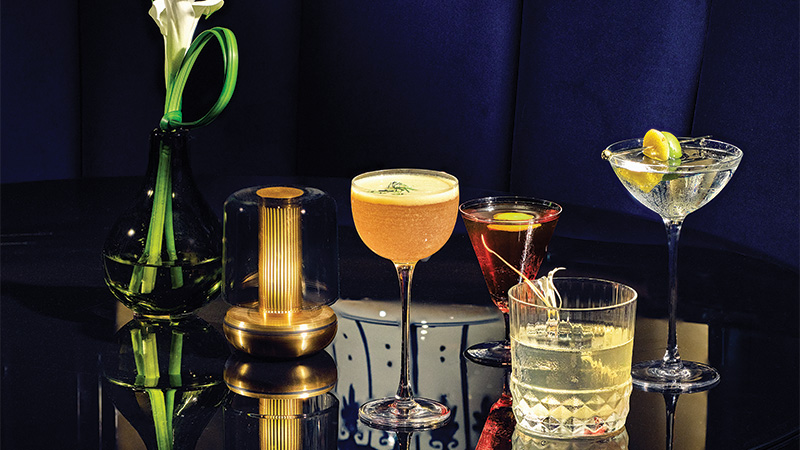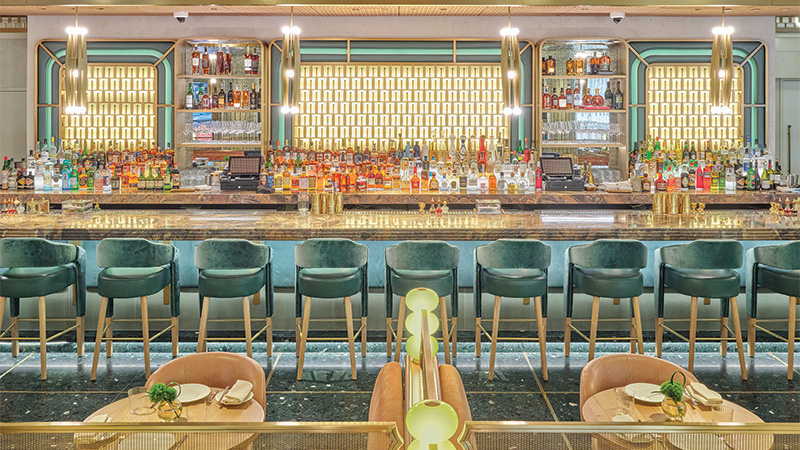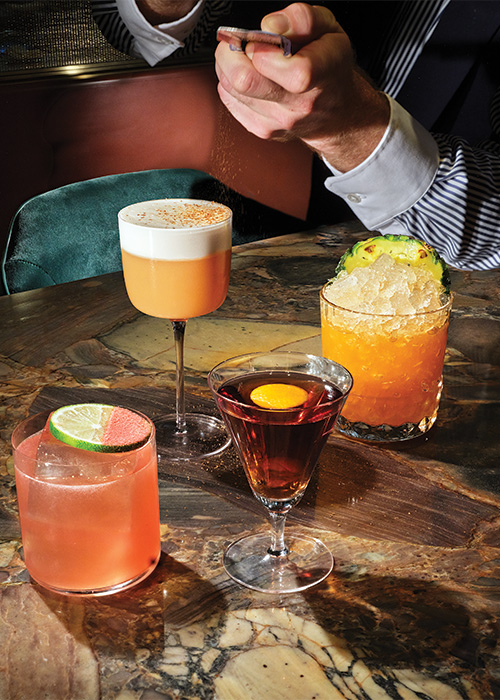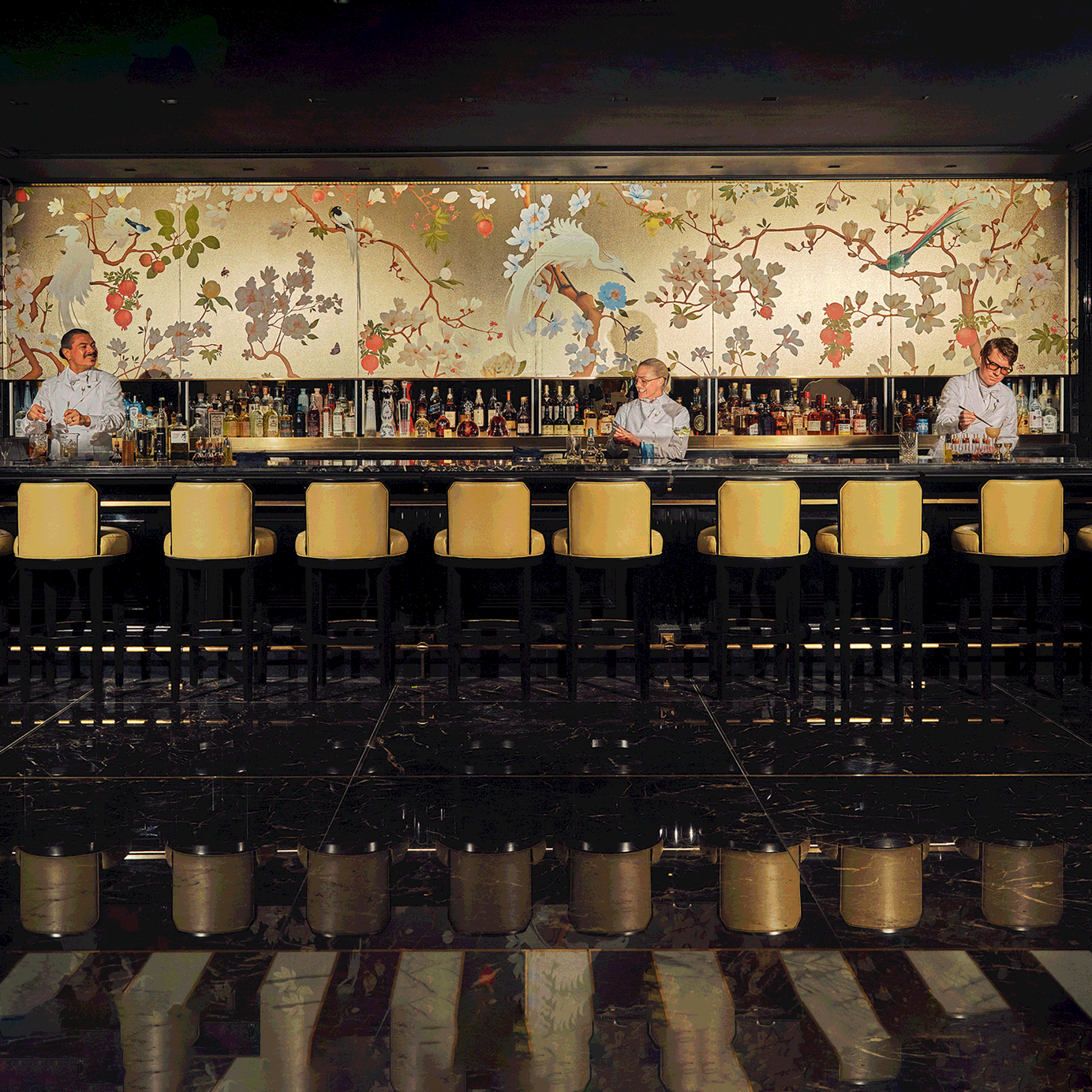New guests at Manhattan’s historic Waldorf Astoria Hotel, which officially opened on July 15 after a lengthy, eight-year restoration, will get a different kind of welcome when they check in. In the past, patrons would make a beeline to the north side of the capacious lobby, because that was where the front desk stood. If they make that same journey today, however, they will come face to face not with a hotel clerk, but a bartender.
This is the new Peacock Alley bar. The name refers to the 300-foot marble corridor that once connected the original Waldorf and Astoria hotels, which stood where the Empire State Building now is. The two hotels were built by rival factions of the Astor family, but were eventually connected. At the time, it was fashionable for New York’s wealthy to promenade along the passageway, peacocking their finery for all to see.
In its most recent incarnation, which lasted until 2017, Peacock Alley sat opposite the front desk and seating was behind a partitioned area. Today, the public part of the new bar encompasses not only the several bar stools that line it, but the entire lobby.
That soaring room is once again anchored by the iconic four-sided clock, originally made for the 1893 World’s Columbian Exposition in Chicago, and featuring relief portraits of Presidents George Washington, Andrew Jackson, Benjamin Harrison, Abraham Lincoln, Ulysses S. Grant, and Grover Cleveland, as well as Benjamin Franklin and Queen Victoria. (The clock, which has also been restored, was kept at the New York Historical Society during the hotel’s renovation.)
Also in the lobby is the ornate piano once owned by composer Cole Porter, who is arguably the hotel’s most famous guest. He lived in the Waldorf from 1934 until his death in 1964. Far from being mere decoration, the instrument will soon regularly fill the bar with historically tinged music.
The Art Deco bar itself shines like an ornament in a long, rectangular jewel box. It is bookended by columns of Nero Portoro black marble and otherwise framed by a wall of polished walnut. The bar-length wallcovering (by textile company Momentum) that serves as a backdrop depicts white peacocks and other birds against shimmering gold.
To steer the cocktail program at the reborn Peacock Alley, the hotel turned to renowned bartender Jeff Bell, who owns PDT, one of the bastions of the modern craft cocktail era in New York. He is also in charge of the drinks list at the hotel’s new restaurant, the two-level Lex Yard, which is piloted by chef Michael Anthony.
Bell was tasked with coming up with 20 cocktails each for Peacock Alley and Lex Yard. For those unfamiliar with the time, effort, and ingenuity that goes into modern mixology, that’s a lot of drinks.
“I like a challenge,” says Bell. “Sometimes I hate that I like a challenge, because it can give me a lot of anxiety. But I find that pressure is good for me. It helps me. The anxiety or stress come from the fact that I want to do well and I care. So, it’s a good thing.” (As if reopening the Waldorf wasn’t enough, Bell is simultaneously readying two new bars in the West Village, Mixteca and Kees, as well as the eatery Tacos 1986.)

Of all the hotels to call New York home over the centuries, the Waldorf Astoria has the most extended connection to cocktail history. Between its original location and its current address, it has inspired at least four cocktail books detailing its liquid legacy.
In 1931, Albert Stevens Crockett, a newspaper columnist and sometime publicist for the hotel, attempted to recapture the glamour of bygone Belle Epoque days with “Old Waldorf Bar Days,” a volume that was published, rather cruelly, while Prohibition was still in effect. After repeal, Crockett published an updated edition, “The Old Waldorf-Astoria Bar Book.” (Another Waldorf publicity man, Ted Saucier, published his own cocktail book, “Bottoms Up,” in 1951.)
In 1934 came “100 Famous Cocktails,” “prepared in collaboration with Oscar of the Waldorf.” Oscar was Oscar Tschirky, the hotel’s famous, long-serving, Swiss-American maître d’hôtel, and purported inventor of the Waldorf salad. Finally, in 2016, Frank Caiafa, then manager of Peacock Alley, lovingly updated the Crockett volumes with his 400-page “The Waldorf Astoria Bar Book.” Unlike the Crockett books, the recipes came with detailed headnotes and mixing instructions. (An updated edition of Caiafa’s book will be published in 2026.)
Bell honors that rich legacy on the first page of the Peacock Alley’s cocktail menu, where he prominently features three old Waldorf drinks: the Waldorf Cocktail; Commodore #2; and Dr. Cook. Each, of course, comes with a few modern updates.
The original Commodore #2 was equal parts bourbon, lemon juice, and crème de cacao with a dash of grenadine. Bell has upped the portion of bourbon and decreased the amount of lemon and cacao, for a more balanced drink. The original Dr. Cook was a gin drink with lemon juice, egg white, and dashes of Maraschino liqueur. Bell has converted it into a vodka cocktail with Maraschino, lime juice, and grapefruit juice.

The Waldorf cocktail was a Manhattan variation with equal parts “whiskey” (no type was specified), sweet vermouth, absinthe, and a dash of “Manhattan bitters.” Bell has wisely demoted the herbal liqueur to a rinse inside the glass. He’s also given the recipe a standard 2-to-1, whiskey-to-vermouth Manhattan profile; and settled on local Jaywalk Rye as the whiskey in question.
From there, the menu ventures into classics and their variations. There’s a list of four Martinis and three Old Fashioneds — two classic cocktails that came into their own during the hotel’s early years.
The Waldorf Martini is a classic gin expression of the drink. The Met Gala — a reference to when that annual event took place at the hotel — is composed of vodka, blanc vermouth, and Vicario olive leaf liqueur; it is meant for the Dirty Martini drinker. The White Tie, made with gin, vodka, Cocchi Americano, and Italicus, sits in Vesper territory. And the 50th St. Martini is an interpretation of the 50-50 Martini, with an assist from the earthy Muyu Vetiver liqueur.
“I feel like a Martini is like a master’s thesis,” says Bell. “The simplest things can be the hardest sometimes.”
The Old Fashioneds include the Little Tokyo (Suntory Toki Whisky, ginger eau de vie, citrus, honey, and bitters); the Empire Old Fashioned (Maker’s Mark bourbon, apple aperitif, sugar, and cardamom bitters); and the Father Time (Cognac, vin santo, walnut liqueur, and walnut bitters).
Turn the page and there are “Seasonal Signatures.” These are original drinks, but ones whose names evoke the hotel’s past. Oscar’s Collins (vodka, sherry, lemon, Granny Smith apple, club soda) is named in honor of Tschirky. That the NBA draft used to take place in the Grand Ballroom is remembered by the Lottery Pick (mezcal, lime, pineapple, passion fruit, agave, and ginger beer). And the Lombardo Spritz (Aperol, grapefruit, rose hip liqueur, Prosecco) pays homage to bandleader Guy Lombardo, who broadcast his famous New Year’s Eve concerts from the hotel for many years.

All these drinks will be available at lunch and dinner at Peacock Alley; breakfasters will find a Bloody Mary and Mimosa at their disposal. The cocktail menu at Lex Yard, meanwhile, features more low-abv and sessionable drinks, the sort of cocktails more suited to a sit-down meal where wine is likely going to take the starring role.
The Waldorf was never a cheap place to stay or drink, and that won’t change now. In a city of ever-increasing cocktail prices, the hotel is raising the bar, not lowering it. Prices begin at $28 and climb into the high thirties. Looking for cocktails for two? Better bring a Benjamin.
But perhaps that is the price one pays for marinating in one of the remaining hotel bar landmarks that possess a throughline to New York’s glorious drinking past. The Oak Room in the Plaza Hotel isn’t reopening anytime soon; this year the hotel started renting it out for private events. There’s still the King Cole Bar in the St. Regis and Bemelmans Bar in the Carlyle. But, for history and pedigree, the Waldorf is the peacock of them all.
